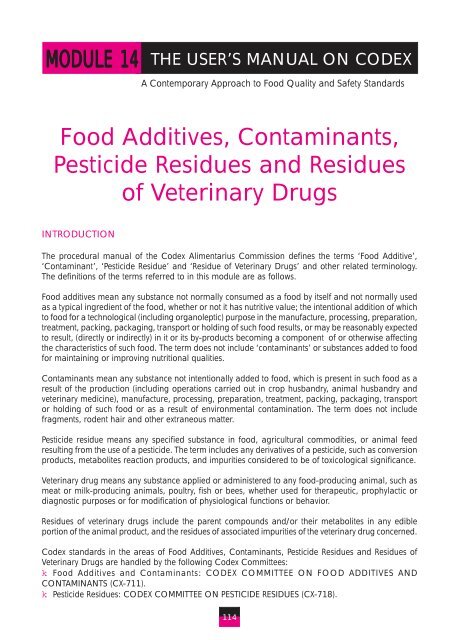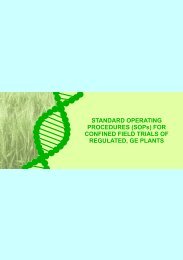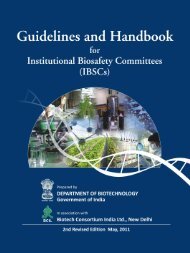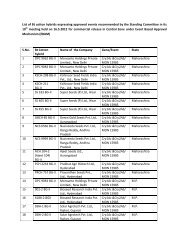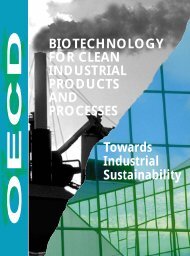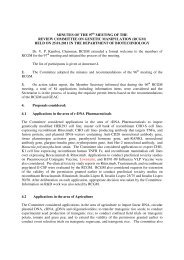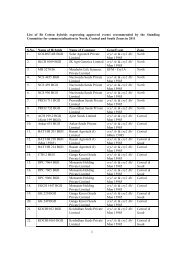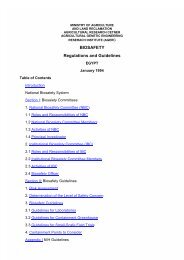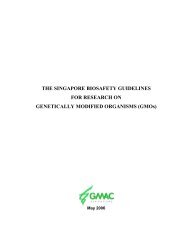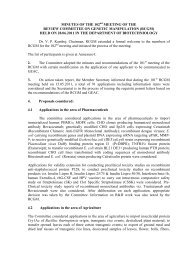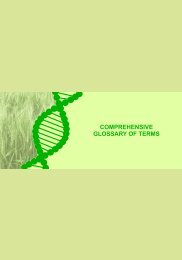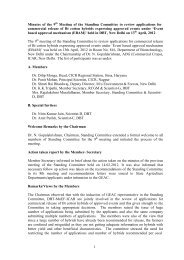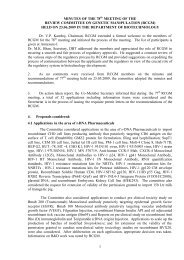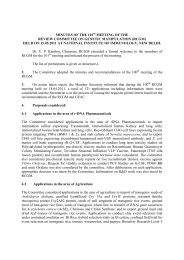THE USER'S MANUAL ON CODEX - Department of Biotechnology
THE USER'S MANUAL ON CODEX - Department of Biotechnology
THE USER'S MANUAL ON CODEX - Department of Biotechnology
Create successful ePaper yourself
Turn your PDF publications into a flip-book with our unique Google optimized e-Paper software.
MODULE 14<br />
<strong>THE</strong> USER’S <strong>MANUAL</strong> <strong>ON</strong> <strong>CODEX</strong><br />
A Contemporary Approach to Food Quality and Safety Standards<br />
Food Additives, Contaminants,<br />
Pesticide Residues and Residues<br />
<strong>of</strong> Veterinary Drugs<br />
INTRODUCTI<strong>ON</strong><br />
The procedural manual <strong>of</strong> the Codex Alimentarius Commission defines the terms ‘Food Additive’,<br />
‘Contaminant’, ‘Pesticide Residue’ and ‘Residue <strong>of</strong> Veterinary Drugs’ and other related terminology.<br />
The definitions <strong>of</strong> the terms referred to in this module are as follows.<br />
Food additives mean any substance not normally consumed as a food by itself and not normally used<br />
as a typical ingredient <strong>of</strong> the food, whether or not it has nutritive value; the intentional addition <strong>of</strong> which<br />
to food for a technological (including organoleptic) purpose in the manufacture, processing, preparation,<br />
treatment, packing, packaging, transport or holding <strong>of</strong> such food results, or may be reasonably expected<br />
to result, (directly or indirectly) in it or its by-products becoming a component <strong>of</strong> or otherwise affecting<br />
the characteristics <strong>of</strong> such food. The term does not include ‘contaminants’ or substances added to food<br />
for maintaining or improving nutritional qualities.<br />
Contaminants mean any substance not intentionally added to food, which is present in such food as a<br />
result <strong>of</strong> the production (including operations carried out in crop husbandry, animal husbandry and<br />
veterinary medicine), manufacture, processing, preparation, treatment, packing, packaging, transport<br />
or holding <strong>of</strong> such food or as a result <strong>of</strong> environmental contamination. The term does not include<br />
fragments, rodent hair and other extraneous matter.<br />
Pesticide residue means any specified substance in food, agricultural commodities, or animal feed<br />
resulting from the use <strong>of</strong> a pesticide. The term includes any derivatives <strong>of</strong> a pesticide, such as conversion<br />
products, metabolites reaction products, and impurities considered to be <strong>of</strong> toxicological significance.<br />
Veterinary drug means any substance applied or administered to any food-producing animal, such as<br />
meat or milk-producing animals, poultry, fish or bees, whether used for therapeutic, prophylactic or<br />
diagnostic purposes or for modification <strong>of</strong> physiological functions or behavior.<br />
Residues <strong>of</strong> veterinary drugs include the parent compounds and/or their metabolites in any edible<br />
portion <strong>of</strong> the animal product, and the residues <strong>of</strong> associated impurities <strong>of</strong> the veterinary drug concerned.<br />
Codex standards in the areas <strong>of</strong> Food Additives, Contaminants, Pesticide Residues and Residues <strong>of</strong><br />
Veterinary Drugs are handled by the following Codex Committees:<br />
k Food Additives and Contaminants: <strong>CODEX</strong> COMMITTEE <strong>ON</strong> FOOD ADDITIVES AND<br />
C<strong>ON</strong>TAMINANTS (CX-711).<br />
k Pesticide Residues: <strong>CODEX</strong> COMMITTEE <strong>ON</strong> PESTICIDE RESIDUES (CX-718).<br />
114


